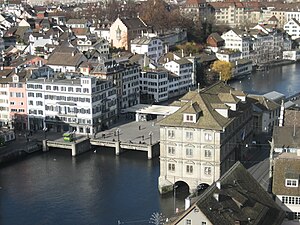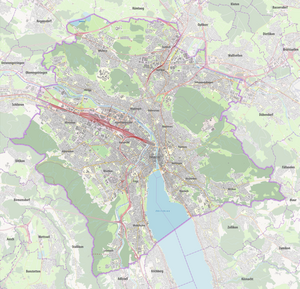Rathausbrücke (Zurich)
Coordinates: 47 ° 22 ′ 18 " N , 8 ° 32 ′ 32" E ; CH1903: six hundred eighty-three thousand three hundred sixty / 247359
| Rathausbrücke vegetable bridge |
||
|---|---|---|
|
Rathausbrücke, on the right the Zurich town hall , on the left the Haus zum Schwert |
||
| Official name | City Hall Bridge | |
| use | Pedestrians, slow traffic | |
| Crossing of | Limmat | |
| place | Old town (District 1), Zurich | |
| construction | Plate bridge | |
| completion | Middle Ages , then renewed several times | |
| opening | 1973 current structure | |
| Status | Renovation needed | |
| planner |
Civil engineer: Edy Toscano Architect: Manuel Pauli |
|
| location | ||
|
|
||
| Bridges in the city of Zurich | ||
The Rathausbrücke , also known as the Vegetable Bridge, is a square-shaped bridge over the Limmat in the city of Zurich ( Switzerland ). The term vegetable bridge is still popular today and is reminiscent of the former vegetable market that took place here. The bridge got its official name from the town hall in 1893 . To distinguish it from the Upper Bridge ( Münsterbrücke ) further upstream, it was also called Lower Bridge .
Location and description
In the old town, the bridge connects the two parts of the city separated by the Limmat. It leads from the right bank of the Limmat with the town hall and Limmatquai to the left bank with the Schipfe and the Weinplatz , which visually merges with the square-like bridge.
In earlier times on Sunday it served the citizens and guilds as a meeting point after the service and representative state acts were held on it. From the early 14th century, the bridge also served as a marketplace, which gave it the name Vegetable Bridge . The Rathausbrücke is still an important meeting point and part of Zurich's pedestrian zone.
history
The town hall or vegetable bridge has been connecting the districts on the left and right of the Limmat since the Middle Ages. It was the first and, until 1838, the only passable Limmat crossing in the city of Zurich. Even in the Middle Ages, the bridge was wider than necessary for traffic, as can be seen on the altarpiece (Twelve Messenger Chapel in the Grossmünster ) by Hans Leu the Elder from the end of the 15th century. The first known widening dates from 1375 and 1420/21. By widening it further downstream, the bridge was roughly the same size as it is today between 1602 and 1605, bounded on the left by the hotel "Zum Schwert" .
Despite its location and importance, it was architecturally not an outstanding building. A wooden platform made of oak boards was attached to the west until the 19th century. Only on the murerplan recognizable from 1576 Breakwater at the inflow side were built of stone, the other bridge parts were mostly made of wood. Regardless of this, the part of the bridge between the town hall and the Hauptwache is likely to be one of the oldest and widest stone bridge structures in Switzerland.
In 1881 the wooden bridge structure was replaced by a cast iron structure by the civil engineer Ludwig von Tetmajer , and the old stalls were removed. Plans to build a vegetable hall on the bridge failed due to popular resistance: a petition prevented this “monument to tastelessness”.
Today's reinforced concrete bridge was designed by civil engineer Edy Toscano together with architect Manuel Pauli and rebuilt in 1972/73. Small restaurants were housed in superstructures on the bridge. Its roof, which consisted of conspicuous pyramid-shaped elements, was replaced by a flat roof just a few years later.
New building from 2023
In 2017 it was announced that the bridge would be replaced by a new building. As a result, the superstructure in need of renovation is to be renewed and the water flow increased so that the water also discharged from the Thalwil flood relief tunnel into Lake Zurich can flow under the bridge without damage.
The winning project was presented to the public in May 2019. It comes from the companies Bänziger Partner AG, 10: 8 Architekten and F. Preisig AG. The trapezoidal plate bridge will have a slightly smaller floor plan than the existing bridge. In order to cope with the larger amount of water, a new pillar arrangement had to be chosen, which made do with two instead of four pillars, but still uses the existing foundations. The span of the main fields of the new bridge will be 24 meters, that of the two secondary fields each 13 meters.
The planned new construction is to start in 2023 and be completed in 2025 or 2026, the start of construction coinciding with the restoration of the town hall. The existing bridge will be dismantled and 4.5 meter wide auxiliary bridges will be used for pedestrian traffic during the construction period. The construction costs are estimated at CHF 32 million.
Limmatstein

The Limmatstein or Metzgerstein was a large boulder in the Limmat directly below the Rathausbrücke. When the water level was low, it protruded from the water as a wide slab of rock; this happened in the years 1580, 1585, 1654, 1740 and finally in 1814. Since the stone hindered navigation, it was largely smashed in 1823. What was left of him was "blown away using dynamite when the new cast-iron bridge was built in the spring of 1881, and the workers received a drink from the butchers."
photos
The town hall bridge collapsed on Whitsun 1375; Representation from the Wickiana
western end of the Rathausbrücke at the end of the 15th century, depiction of Hans Leu the Elder
Town hall bridge on the Müllerplan 1793
Town hall bridge and surroundings on the Murer map from 1576
Web links / sources
Individual evidence
- ↑ a b c d e Clementine Hegner-van Rooden: Both place and bridge . In: SIA (Ed.): TEC21 . No. 29-30-31 , 2019, pp. 8-9 .
- ^ Thomas Germann, Jürg E. Schneider: Zurich in Time Lapse , Volume II, Werd-Verlag, Zurich 2000, p. 74, ISBN 978-3-85932-322-3 .
- ↑ Adi Kälin: Vegetable bridge will be replaced . In: Neue Zürcher Zeitung . No. 150 , July 1, 2017, p. 23 ( nzz.ch ).
- ↑ Bruno Weber: Planvedute Zurich. Commentary on the reproduction of the originals in the Zurich Central Library , Matthieu Verlag, Zurich 1986








